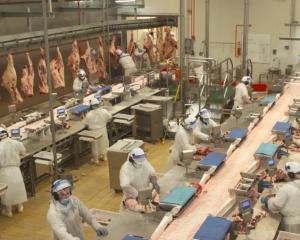
Central Otago sheep and beef farmer Tim Davis has joined a group of farmers in a programme aiming to increase the use of high-quality genetics in the beef industry.
"We are trying to accelerate our genetic gain. As a farmer, you always have to get more efficient. If you don’t change, you’ll be struggling in 10 years’ time. You’ve always got to be looking to improve."
The Informing New Zealand Beef programme aims to boost the sector’s profits by $460 million.
Another 10 commercial beef farmers from across New Zealand were recently selected to be part of the programme including Mr Davis’ farm Longacre Station in Lindis Valley.
The 3340ha Longacre Station spans from the valley to the foot of St Bathans Range and includes 300ha of irrigated flats and 800ha of cultivatable hills.
Livestock usually run on the station consists of 180 cows, 60 heifers and up to 6000 merino ewes, about half of them producing ultrafine wool.
The size of the heifer herd halved due to dry conditions biting between November and mid-April.
Mr Davis left a career as an interest rate derivatives trader, working for banks in Sydney, London, Singapore and United States, to be the third generation of his family to run the station since 1960.
Mr Davis wanted his commercial farm Longacre Station to be in the programme because he was exploring an idea of artificially inseminating his heifers and the programme appealed because it paid the cost to get genetic evaluations of his 180 beef cows.
He pays the $50 cost per animal to test his calves.

The genetic data was used on Longacre Station to help select replacement heifers.
Any heifers which failed to make the cut were sold for fattening.
A herd of 14-month-old heifers on Longacre Station, weighing between 375kg and 400kg, were put to a bull.
Previously, the top 25% of heifers to be mated and return to the herd were selected by eye.
"We used to just take the biggest."
The genetic data for the heifers shows the biggest were not always the best for producing the most profit.
Two heifers could look identical but one had data to show it had greater potential to produce calve which grew to heavier weights faster.
All of the calves born on Longacre Station remained there for a year, wintered on fodder beet until October.
Steer yearling calves were sold to Pete Jolly’s fattening enterprise in Tarras.
"We want high growth rates up to a yearling for us but we also want really good carcass traits so he [Mr Jolly] makes money at the other end."
The genetics of the steers allowing them to be finish quickly to heavier weights and fetch premiums, such as intramuscular fat, which would help the continue the business relationship with Mr Jolly.

He paid $13,000 for composite bull EHCC 233019 from Earnscleugh Station this year.
The rising 2-year-old bull is the progeny of sire GW Copperhead 919G and dam Selby 155006.
Longacre Station selected bull breeds, such as composite and Angus, to ensure the progeny had "hybrid vigour" from crossbreeding.
Composite cattle suited his farm system.
"They are easy calving, really docile and they fatten really quickly ... we can finish them in about 16 months."
Possums were spreading bovine tuberculosis in the area.
The disease had not been detected in his herd but if it was, the only option was to finish all the calves themselves so the better genetics would help get them to heavier weights and get them on the truck to the meatworks earlier.
Beef + Lamb New Zealand and the Ministry for Primary Industries’ Sustainable Food and Fibre Futures fund support the seven-year programme developing New Zealand-specific breeding indexes, running a beef progeny test and linking in data from commercial herds.
As part of the programme, online genetics tool nProve Beef was launched in March to help farmers select the best bulls for their farm business.
The nProve tool would make it possible for farmers to compare a bull’s estimated breeding values with "hard data", such as growth rates on farm, Mr Davis said.
Programme commercial herds project lead Sonya Shaw said the 10 new farms in the programme increased the number of properties to 47.

Commercial farms were an important part of the programme, as they provide increased linkages throughout the beef industry and contribute to genetic evaluations through recording data and incorporation of data into breeding value prediction, Dr Shaw said.
"Ultimately this will increase the accuracy with which breeding values, or genetic merit, can be estimated."
The programme helped commercial farmers understand the value of better genetics and offered them the opportunity to easily select the right genetics for their system to drive greater profitability on their farms.
The 10 new farmers were from Otago, Marlborough, Wellington Manawatu-Whanganui, Hawke’s Bay, Waikato and Northland.
Cattle breeds represented on those farms comprise Angus, South Devon, Angus-Charolais-Simmental cross and composite cattle.
Participation in the programme helps the farmers to achieve more accurate heifer selection in their herds, she said.
"Which will have a lasting impact on these commercial herds’ progress."
The commercial farmers provide the programme with accurate pedigree recording, assessing bull teams’ performances, ensuring accurate information for heifer replacement selection and work with their bull breeders to make more rapid genetic progress.
Farmers adopt a recording schedule across the year and could carry out genotyping of their cow herd and calves and sires.
"They are also able to benchmark their herd against others involved in the programme," Dr Shaw said.














